Electricity Around Us Quiz
Congratulations!
1 of 30
Which of these appliances do you plug into the wall for mains electricity?

- Portable hand game console
- Television remote control
- Toaster
2 of 30
Which of the following items do not use electricity?
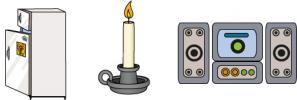
- A fridge
- A candle
- A stereo
3 of 30
Which of these statements are correct?
- A battery has a positive and a positive end
- A battery has a negative and a negative end
- A battery has a negative and a positive end
4 of 30
What does this symbol represent?

- Light bulb
- Battery
- Switch
5 of 30
What is wrong with this picture?
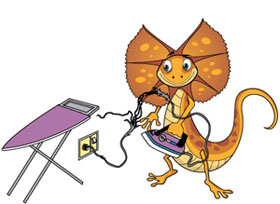
- The electrical cord has not been plugged into the power point
- The electrical cord is damaged
- The electrical cord is the wrong colour and should not be used
6 of 30
Which of these statements are correct?
- Mains electricity comes from a battery
- Mains electricity is weaker than a battery
- Mains electricity is very powerful and can be dangerous
7 of 30
What does this symbol represent?
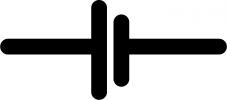
- Wire
- Light bulb
- Battery
8 of 30
Which of these statements is correct?
- Electricity will flow when all the wires are not connected in a circuit
- Electricity does not flow through a circuit
- Electricity will flow when all the wires are connected in a circuit
9 of 30
Which of these statements is true:
- Electricity's main aim is to travel up into the sky
- Electricity's main aim is to travel down to Earth
- Electricity's main aim is to not go anywhere
10 of 30
Why is mains electricity more dangerous than batteries?
- The cases around batteries protect people from the electricity inside them
- Mains electricity is much more powerful than batteries
- Mains electricity plugs are bigger than batteries
11 of 30
RCD stands for:
- Really Cool Dude
- Residual Current Device
- Red Coloured Diode
12 of 30
It is the law in Australia for every household to have this many RCD switches:
- 3
- 1
- 2
13 of 30
A conductor is a material that:
- Does let electricity travel through it
- Chooses when to let electricity travel through or not
- Does not let electricity travel through it
14 of 30
Which type of material protects people from being electrocuted?
- Conductor
- Insulator
- Semi-conductor
15 of 30
Which of the following objects do not use electricity?
- A bicycle
- A toaster
- A washing machine
16 of 30
How does electricity get into your home?
- Through a hole in the wall with an on/off switch
- Through a meter box
- Using magnetism
17 of 30
What is wrong with this picture?
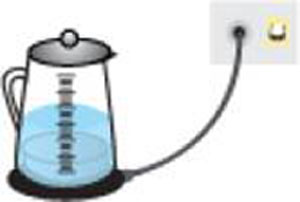
- The kettle has no water in it
- The kettle is not switched on
- The kettle has a frayed cord
18 of 30
Water is:
- A conductor
- An insulator
- A semi-conductor
19 of 30
Which of these statements is true:
- Remote controls use mains power
- Substations make good hide outs
- Electricity is dangerous and will kill you if not used properly
20 of 30
Which of the following is a correct fact about batteries?
- Batteries use sunlight to work
- Batteries use chemicals to create electricity
- Batteries use magnets to create electricity
21 of 30
What is the voltage of this battery?
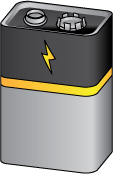
- 9 volts
- 1.5 volts
- 15 volts
22 of 30
What is this battery used to power?
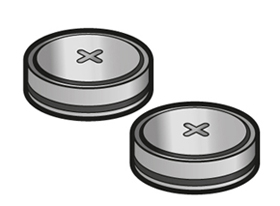
- Torch
- Watch
- Car
23 of 30
What electrical components are shown in this diagram?
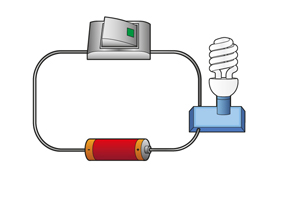
- A battery or cell, a light bulb and a switch
- A buzzer, a switch and a battery
- A motor, a light bulb and a switch
24 of 30
Will the light bulbs in this circuit light up?
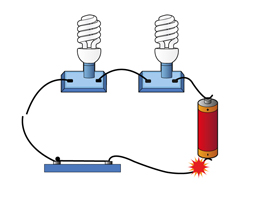
- Yes
- No
25 of 30
Will the light bulbs in this circuit light up?

- Yes
- No
26 of 30
Static electricity is:
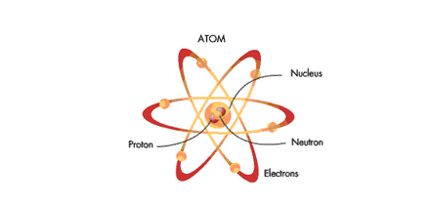
- The flow of electrons through a wire
- The build up of electrons in one place
- The backward movement of electrons
27 of 30
Current electricity is:

- The build up of electrons
- The backward movement of electrons
- The flow of electrons through a wire
28 of 30
Electrons are part of:

- Atoms
- Neutrons
- Protons
29 of 30
The flow of electricity is measured in:
- Volts
- Seconds
- Amperes
30 of 30
How many volts of mains electricity travels around your house ?
- 32,000 volts
- 240 volts
- 16,000 volts